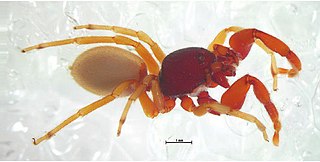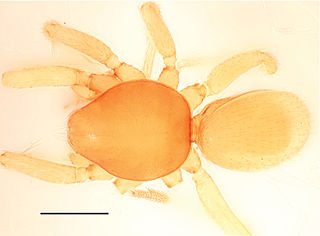
Oonopidae, also known as goblin spiders, is a family of spiders consisting of over 1,600 described species in about 113 genera worldwide, with total species diversity estimated at 2000 to 2500 species. The type genus of the family is OonopsKeyserling, 1835.

Crevice weaver spiders (Filistatidae) comprise cribellate spiders with features that have been regarded as "primitive" for araneomorph spiders. They are weavers of funnel or tube webs. The family contains 18 genera and more than 120 described species worldwide.

Norman Ira Platnick was an American biological systematist and arachnologist. At the time of his death, he was a professor emeritus of the Richard Gilder Graduate School and Peter J. Solomon Family Curator Emeritus of the invertebrate zoology department of the American Museum of Natural History. A 1973 Ph.D. recipient at Harvard University, Platnick described over 1,800 species of spiders from around the world, making him the second most prolific spider taxonomist in history, behind only Eugène Simon. Until 2014 he was also the maintainer of the World Spider Catalog, a website formerly hosted by the AMNH which tracks the arachnology literature, and attempts to maintain a comprehensive list, sorted taxonomically, of every species of spider which has been formally described. In 2007 he received the International Society of Arachnology's Bonnet award, named for Pierre Bonnet, in recognition of his work on the catalog.

Palpimanidae, also known as palp-footed spiders, is a family of araneomorph spiders first described by Tamerlan Thorell in 1890. They are widely distributed throughout the tropical and subtropical regions of the world, the Mediterranean and one in Uzbekistan, but not Australia. They are not common and there is a high degree of endemism.

The Haplogynae or haplogynes are one of the two main groups into which araneomorph spiders have traditionally been divided, the other being the Entelegynae. Morphological phylogenetic studies suggested that the Haplogynae formed a clade; more recent molecular phylogenetic studies refute this, although many of the ecribellate haplogynes do appear to form a clade, Synspermiata.

Unicorn ("one horn", in Latin) is a genus of goblin spiders from South America, containing seven species that occur predominantly in high elevation, semi-desert regions of Bolivia, Chile, and Argentina. Individuals are relatively large for goblin spiders, measuring up to 3.0 mm (0.12 in) in body length. The genus name refers to a characteristic pointed projection between the eyes and jaws of males. In at least one species, broken-off tips of the male pedipalps have been found within the genitalia of females, postulated as a means of sperm competition. Unicorn possesses several traits that suggest it is a relatively "primitive" member of the Oonopidae, and is classified with other similar, soft-bodied goblin spiders in the subfamily Sulsulinae.

Bannana is a genus of goblin spiders native to Xishuangbanna prefecture, Yunnan Province, China, where it lives in the leaf-litter of tropical rainforest. There are two known species: Bannana crassispina and B. parvula, both described in 2015. Individuals are pale yellow and unpatterned, and range from around 1.0 to 1.8 mm in body length, with females being slightly larger than males. The eyes are reduced or entirely absent. Known only from a nature reserve in Xishuangbanna, Bannana belongs to a group of Asian goblin spiders known as the "Dysderoides complex", that ranges from China to Pakistan and south to Indonesia.
Aprusia is a genus of goblin spiders in the family Oonopidae, containing eight accepted species. seven species are endemic to Sri Lanka and the other species is endemic to India.
Aprusia kataragama is a species of spider of the genus Aprusia. It is endemic to Sri Lanka.
Aprusia veddah, is a species of oonopid spider of the genus Aprusia. It is endemic to Sri Lanka.
Birabenella is a genus of spiders in the family Oonopidae. It was first described in 2010 by Grismado.
Dysderoides is a genus of spiders in the family Oonopidae. It was first described in 1946 by Fage. As of 2017, it contains 6 species, found in Thailand and India.
Neotrops is a genus of spiders in the family Oonopidae. It was first described in 2013 by Grismado & Ramírez. As of 2017, it contains 28 species.
Trilacuna is a genus of goblin spiders native to Southeast Asia, first described by Tong & Li in 2007. They look similar to members of Silhouettella, but males can be distinguished by their large palpal femur, among several other more complicated defining features. The name is a combination of the Latin terms "tri" and "lacuna", referring to the three-branched endites in males and the three-notched labium in females.
Gradunguloonops is a genus of spiders in the family Oonopidae. It was first described in 2015 by Grismado et al.. As of 2017, it contains 12 South American species.
Fernandezina is a genus of South American palp-footed spiders that was first described by M. Birabén in 1951.
Conifaber is a genus of spiders in the family Uloboridae. It was first described in 1982 by Opell. As of 2017, it contains 4 species, all from South America:

Synspermiata is a clade of araneomorph spiders, comprising most of the former "haplogynes". They are united by having simpler genitalia than other araneomorph spiders, lacking a cribellum, and sharing an evolutionary history of synspermia – a particular way in which spermatozoa are grouped together when transferred to the female.
Almafuerte is a genus of South American ground spiders first described by C. J. Grismado & N. L. Carrión in 2017.







